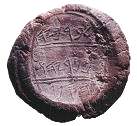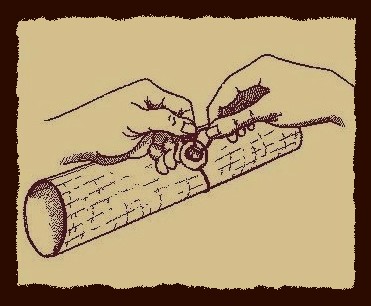

Bullae are created by seals, pressed into a lump of clay, primarily attached to a document of papyrus or parchment that it sealed. The documents would be rolled and tied by a cord. The bullae were then imprinted on the knot or the cord itself to ensure that it could not be opened without breaking the seal or cutting the cord, indicating that it had been opened. Bullae were also known to be on jar handles. The bullae were dried, but not fired, which would have burned whatever they were sealing. When Yahudah [Judah] was overtaken by the Babylonians in the First Temple Period, fires destroyed part of the buildings. While destroying the document that they sealed, the fires fired the clay bullae, making them hard and preserving them. It is primarily the Biblical Period bullae that I have been researching. The time period is known by dating, orthography [writing] as well as the names on the seals.

I originally started researching Hebrew bullae when I was looking into archaeology connected with the name YHWH and the aspect of the theophoric element Yahu. Theophoric is Greek and means to bear theo (god). By bearing part of a deity’s name, was to invoke that deity, as well as bearing the name for protection. This was a common practice in the Mesopotamian and Near Eastern areas. There are cases of name changes from one deity to another. A classic example is that of the famous, young, Egyptian king Tutankhamun. His original name was Tutankhaten, representing the worship of Aten, from his parents Amenhotep III and Nefertiti. Shortly after becoming the king, he changes his name to Tutankhamun, showing a return to the worship of the main deity Amun.
I have a copy of a book by Nahman Avigad, 1986, called, "Hebrew Bullae From the Time of Jeremiah: Remnants of a Burnt Archive." This book shows a grouping of bullae, which are clay seals, about the size of buttons, used on documents, such as land titles, contracts and declarations. These bullae are from the collection of Yoav Sasson. Though YirmeYahu is not on a seal, his scribe BerekYahu [Baruch] ben NeriYahu is. But BerekYahu is not the only one from that time, one of the king’s sons, Yerachmeel, is also on a bullae. He is mentioned in YirmeYahu 36:26. Other names from YirmeYahu’s time are represented on the seals, but with no certainty if they are the exact people involved.
The book presents 255 seals in various conditions. Some of the seals are repeats of the same seal. The bullae represent 132 different names. Of the names, most of them are theophoric, which means that they have a prefix or suffix of a deity added to their name. 80 of the 132 names, have the prefix or suffix of YHW. Some other seals have damage to the sides that do not have the full name mentioned. Like the waw of YHW was chipped off the edge of these seals. They are assumed to be YHW names, but are not counted with the 80, since the full name is not known for sure. 8 names have el. The remainder are either broken names or names that do not have the theophoric element at all.
There are several interesting facts about these seals.
1. They all date to the time just before the exile to Babel.
2. They show the prefix Yahu and the suffix Yahu was the majority theophoric element in this particular collection, representing the time prior to the exile. This is also confirmed by the Lachish Letters and the Arad Inscriptions, both of which are prior to the exile.
3. They show the predominance of Yahu names over el names.
4. They show the full spelling of BerekYahu, which has been shortened in the Tanak to just “Baruch”.
5. They confirm the existence of several people in the Scripture.
Another book on the subject is, “Messages from the Past: Hebrew Bullae from the Time of Isaiah Through the Destruction of the First Temple”, by Robert Deutsch, 1999. These seals are from the Shlomo Moussaieff collection. Deutsch also co-authored another book with Andre Lemaire, 2000, “Biblical Period Personal Seals in the Shlomo Moussaieff Collection.” The latest book I have is “Biblical Period Hebrew Bullae, The Josef Chaim Kaufman Collection,” by Robert Deutsch, 2003. The Kaufman collection consists of 516 bullae, all except for 2 are Hebrew. 421 different seals are represented. This collection dates primarily to the second half of the 8th and 7th century B.C.E. These bullae were not fired. There is also a CD that has seals from more than just Yisrael, titled, “Seals, A Journey in Time.” Numerous other archaeological journals and books have covered a few of the seals, but so far, the books by Avigad and Deutsch have the largest collections. I would highly recommend these materials to anyone interested in seeing these beautiful bullae.
What caught my eye, besides theophoric Yahu names, was the iconography that was also on some of the bullae. Iconography literally mean image writing from the Greek, eikono – icon and graphia – writing. An example, which will be covered in more detail in the bullae section, is that of a king of Yahudah, ChizqiYahu [Hezekiah]. He has seals that bear two-winged sundisks with Egyptian ankhs on both sides and Egyptian winged scarabs with solar disks. This is a similar situation to that of the Roman emperor Constantine. Christian history writes that Constantine became a convert to Christianity and when he was dying in 337, was baptized by his friend, Eusebius, who was the Bishop of Nicomedia, an Arian Christian. In his early reign, his coins show Mars as his patron god, but in 310 CE and after, even to the year that he died, the coins have Sol Invictus as his patron, the Invincible Sun. Constantine was the High Priest of the cult of Sol Invictus and declared Sunday to be the Romans day of rest. This sounds very “christian.”
So here we have a Jewish king of Yahudah, that the Jewish Bible writes, “He did what was right in the eyes of YHWH, just as his father David had done, “ II Melekiym [Kings] 18:3. Verse 5 and 6 states, “he trusted in YHWH the elohey of yisrael, and after him there was none like him among all the kings of yahudah, nor who were before him; 6 and he clung to YHWH; he did not turn aside from following him, and kept his commands that YHWH commanded mosheh.” If these written words are true, then why has archaeology uncovered seals for this king that have Egyptian sun-god and ankh iconography on them? Cause I distinctly remember a certain commandment that states, " ‘i am YHWH your elohey, who brought you out of the land of mitsrayim, out of the beyth of slavery. 3 you will have no other elohiym before my face. 4 you will not make for yourself an idol, or any likeness of what is in the heavens above or on the earth beneath or in the water under the earth. 5 you will not worship them or serve them; for i am YHWH your elohey, a jealous el, visiting the iniquity of the fathers on the sons, on the third and the fourth generations of those who hate me, 6 but showing kindness to thousands, to those who love me and keep my commandments.’ “ – Shemoth [Exodus] 20:2-6.
This is exactly why I like to delve into archaeology, to weed through the “lying pens of the scribes” and see what the “talking stones” have to say.
